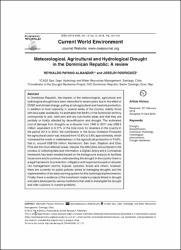| Sinopsis: | In Dominican Republic, the impacts of the meteorological, agricultural and hydrological drought have been intensified in recent years due to the effect of ENSO and climate change, putting at risk agricultural and livestock production, in addition to food insecurity in several areas of the country, mainly those with less water availability. It’s estimated that 69.6% of the Dominican territory corresponds to arid, semi-arid and dry sub-humid areas and that they are partially or totally affected by desertification and drought. The estimated cost of damage from droughts as a disaster from 1900 to 2011 was US$ 5 million, equivalent to 0.17% of the total costs for disasters in the country. In the period 2014 to 2015, the contribution to the Gross Domestic Product of the agricultural sector was reduced from 10.8% to 5.8% approximately, which increased the credit or indebtedness to the agricultural production in 14.6%, that is, around US$129 million. Montecristi, San Juan, Dajabón and Elias Piña are the most affected areas.
|
| Autor(es): | Payano-Almanzar, Reynaldo
Rodríguez, Joselín
|
| Año: | 2018
|
| Publicado: | Current World Environment, 13(1), 124-143
|
| Citación: | Payano-Almanzar, R., & Rodríguez, J. (2018). Meteorological, agricultural and hydrological drought in the Dominican Republic: a review. Current World Environment, 13(1), 124-143. Recuperado de:
|
| URI: | https://bvearmb.do/handle/123456789/4067
|


